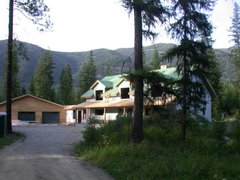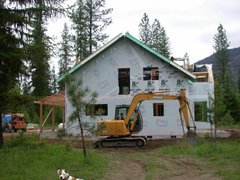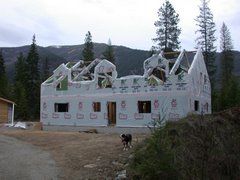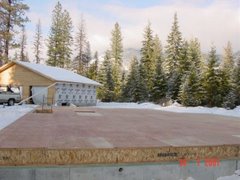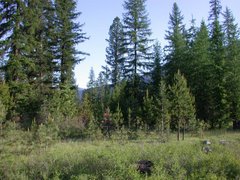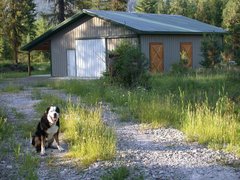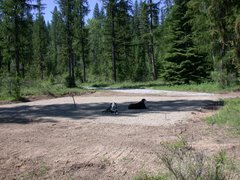There is one "supermarket" in our local town: Harvest Foods. Here's what I like about it:
1. All the signs are in English.
2. The prices aren't any higher than Yakima.
3. You can go to the store in your grubbiest work clothes, ball cap, and no makeup, and nobody cares because most folks look that way.
4. You ALWAYS see someone you know or at least recognize.
5. All the signs are in English...woops, I said that already.
Thursday, August 2, 2007
Friday, July 27, 2007
"Behind Door #1..."

Things are shaping up on the inside. The fireplace and kiva structures are in place, as well as the chimney they share. Of course, nothing is as simple to build as it is to envision, especially if the architectural plans just don't work. Larry's had to modify a lot of things as he goes along, as illustrated in the photo above. This is part of a wall between the master bath and dressing room. The beam sort of "got in the way."
Thursday, July 26, 2007
What Body of Water Is That?


The body of water in the photos above and at the top of this blog is Noxon Rapids Reservoir, one of several impoundments of the Clark Fork River on its way to Lake Pend Oreille and on to the Columbia.
We can only assume there used to be rapids in this stretch before the dams. Now it's deep and and usually as glassy as it is in the photo. It makes for perfect lake kayaking, one of my new passions. On the weekends there are a few waterskiers and jet skis, and numerous fishing boats. There are a few private docks farther upriver from us, and a public boat launch in Trout Creek which is about 8 miles downstream.
At no time, however, could you consider it "crowded," and most of the time it's totally serene.
Best of all, it's just a 5-minute from our house to the point where we took these pictures. This is where I launch my kayak, and it's also where our dogs wade and swim.
Wednesday, July 25, 2007
Our Wild Neighbors


Oh yes, we have wildlife living with us at Shorthorse.
Deer, mostly whitetail but we've spotted a couple mulies too. The deer are ALWAYS there.
Elk. We had a herd living in our yard last winter. We expect that to change when the place is fully occupied, but they'll still be close by.
Bears. Larry, our builder, saw a small black bear amble down the driveway last month when the crew was sitting in the garage eating lunch!
Geese. Lots and lots of local geese.
Turkeys. These comics are pretty plentiful.
Exit of the Yakima Club
Four years ago, three Yakima couples accidentally came together with a common quest: to find retirement property in Sanders County, Montana.
We were basically acquainted with each other beforehand, but it was a surprise to find out we had a common goal.
Don and I had already chosen Thompson Falls as our destination. Lee and Charlotte were next. Lee's a truck driver, and for years he'd enjoyed a regular route through Thompson Falls. He'd fallen in love with the area, and Charlotte was thrilled with the prospect of moving there. Mike and Sue had connections in the Thompson Falls area, and they recognized it as a real gem for anyone who hunts, fishes, and enjoys small-town conservative life.
Somehow we all connected with each other and formed "The Montana Club." We'd get together for dinners or barbecues at each other's homes. We'd share our property-search progress reports, along with tips we'd picked up about the area.
Lee and Charlotte were the first to actually buy property...20 view acres on which they'd build a log home. Within a couple months, we'd bought our 41 acres, about 5 miles down the road from them! And about 18 months later, Mike and Sue found their parcel, 50 view acres with an existing house and barn.
Lee and Charlotte sold their Yakima home just last week, and will be renting a house in Thompson Falls until their log home is built next year. Mike and Sue will be permanently relocating to Thompson Falls within the next couple years. They want to do some remodeling first, plus they're both still employed in Yakima and own a big house here. Don and I, of course, plan to be gone from Yakima by mid-October of this year.
When all six of us get moved, we'll still rotate house to house for dinners. A wonderful friendship has formed between us. But we'll have to change the name of the group from "The Montana Club" to "The Yakima Club."
We were basically acquainted with each other beforehand, but it was a surprise to find out we had a common goal.
Don and I had already chosen Thompson Falls as our destination. Lee and Charlotte were next. Lee's a truck driver, and for years he'd enjoyed a regular route through Thompson Falls. He'd fallen in love with the area, and Charlotte was thrilled with the prospect of moving there. Mike and Sue had connections in the Thompson Falls area, and they recognized it as a real gem for anyone who hunts, fishes, and enjoys small-town conservative life.
Somehow we all connected with each other and formed "The Montana Club." We'd get together for dinners or barbecues at each other's homes. We'd share our property-search progress reports, along with tips we'd picked up about the area.
Lee and Charlotte were the first to actually buy property...20 view acres on which they'd build a log home. Within a couple months, we'd bought our 41 acres, about 5 miles down the road from them! And about 18 months later, Mike and Sue found their parcel, 50 view acres with an existing house and barn.
Lee and Charlotte sold their Yakima home just last week, and will be renting a house in Thompson Falls until their log home is built next year. Mike and Sue will be permanently relocating to Thompson Falls within the next couple years. They want to do some remodeling first, plus they're both still employed in Yakima and own a big house here. Don and I, of course, plan to be gone from Yakima by mid-October of this year.
When all six of us get moved, we'll still rotate house to house for dinners. A wonderful friendship has formed between us. But we'll have to change the name of the group from "The Montana Club" to "The Yakima Club."
Tuesday, July 24, 2007
The Train

If you're looking for property in the beautiful Clark Fork River Valley, you'll be hard-pressed to find it without BIG POWER LINES running near or through it, ROAD NOISE from Highway 200, or the TRAINS (up to 22 per day).
Highway noise was unacceptable to us. We really didn't want power lines either, if we could avoid them. But we liked the lonesome, intermittent sound of a train winding its way through a serene river valley.
At Shorthorse, there is NO highway noise. Nor are there any overhead power lines within sight. But our house is about 200 yards from the railroad tracks. The house sits up on a bench; the tracks are down below, with a thick screen of pines, firs and tamaracks hiding them from view. The trees also temper the sound, which isn't unpleasant to us anyway. Beyond the tracks is the Clark Fork River. The opposite bank of the river is mountainside. This topography lends itself to long echoes. You get to hear every train whistle twice: once in real time and a shadow of it a second later when it bounces off the mountainside.
Our first night there, in the 5th wheel, we lay awake waiting and listening for the far-off approach of a train. We were aware of only two that night. Since then, we don't even hear them anymore!
We like the trains. When we're awake, we enjoy the low, powerful, rumbling of these occasional visitors passing through. Each train has its own personality, defined by the whistle, the engineer who stylizes his whistle blows, the speed of the train, and the cargo it's carrying.
The area immediately below our home is officially known as "Childs Siding." Sometimes when we hear trains idling, switching, and hissing down there, we're drawn like little kids to jog down the hill and get a close-up look. It's better than a Lionel train set!
Maybe when we get settled, I'll bake cinnamon rolls on a dark winter morning and race down the hill to give them to the engineers sitting down there in their locomotives, waiting for a train to pass from the opposite direction.
A House for Dog Kids

Our dogs share our lives, and thus our house. When we designed the Shorthorse lodge, we wanted it to be dog-friendly and unfussy. We also wanted easy maintenance and tough. I didn't want us heartbroken and cussing the dogs the first time we got toenail scratches on brand new doors or floors.
So here are some of the features we incorporated to make it a "dog house."
1. Ceramic tile floors in high-traffic areas. The tile is a slate-type gray, with matte finish and semi-rough surface for paw traction. Dogs love lying on cool tile floors on a hot day.
2. Cultured stone up to the window sills in the living room. Wouldn't show scuffs, claws, and dog goobers. The window sills would be stone (toenail-proof). We anticipate the dogs will be standing on them a lot, barking at the wildlife in the yard.
3. A "dog-proof room" that also serves as the laundry and mud room. We can shut them in there if we really have to on some rare occasion. Vinyl floors, easy-care cabinets, storage for dog food bins, and...a four-foot steel groming tub, complete with ladder and sprayer! The tub will also serve as a utility tub for washing horse blankets or whatever.
4. Two doggy doors in the breezeway; one accesses the laundry room, one accesses the back yard (which will be fenced with 5' chain link).
5. Hardwood flooring in two rooms, but it will be casual, almost pre-distressed.
6. A built-in dog bed nook in the living room. That was the architect's idea. Our dogs prefer to be on our bed, couch, or floor next to us, but maybe we can make this built-in thing work once in a while.
7. Front porch and back patio made of stamped concrete instead of wood or Trex. Again, scratch-proof and chew-proof.
8. Furniture that is "pre-distressed" and rustic.
9. Rustic doors, sort of Shaker style, that won't look ruined if they get scratched.
10. A three-stop elevator to help our elderly dogs get up and down the stairs (okay, so it's for us when we're lazy or lame...but the old dogs will use it too, as soon as they learn how to push the buttons).
Top photo of four dogs: our kids Grasel, Atlas, Lizzie, and Kosmo. Lizzie is a year-old pit bull. The other three are Greater Swiss Mountain Dogs. Kosmo is about 10 years old. Grasel and Atlas are littermates, 11 years old in this photo. We lost our little girl Grasel in May 2007, about two months after this photo was taken. Her ashes are waiting to be freed at Shorthorse, when we finally get moved later this year.
The Weather and Climate


"Montana? Sure hope you like wind and lots of snow!!"
We hear this a lot from our skeptical friends in Yakima when we tell them our plans to move. Then we have to explain the following: Sanders County is known as the "Banana Belt" of Montana. It's in the extreme northwestern corner of the state. As Jake Spoon would say, "You can smell Canadee from there." Sanders County is a large piece of real estate encompassing the WETTEST area of the state (Heron, on the west end of the county) and the DRYEST area (Hot Springs, on the east end). It also has the HOTTEST average temperature (our town, Thompson Falls, in the middle) Snow can be light, moderate or heavy, depending on the the annual whims of nature. But every summer we have quite a few days of 100+ heat. The saving grace is that it cools off so much at night. Typically a midsummer morning can start at 45 degrees and zoom to 102 by 3 p.m.
The real secret, however, is the LACK OF WIND. We might get some pleasant, playful gusts in the early evening, but basically there is NO APPRECIABLE WIND in Sanders County. 3 to 5 mph is a high average! The next question our skeptical friends will ask is, "Just how familiar are you with the area?" They think we've been sold a bill of goods, weatherwise, by the local Chamber of Commerce. It's nice to be able to say, "We've owned the property for four years."
Monday, July 23, 2007
What's Taking So Long?


It was Labor Day Weekend '05, when we gave the architect our rough sketches for the house. Now it's July '07 and we still don't have a finished house. What's taking so long?
It started with the architect.
We decided to hire an architect because we felt the scope of our project called for more than a design engineer. We didn't want to make ANY mistakes, like forgetting closets or leaving insufficient room for doors and drawers to open properly. Plus, we wanted it to be artistically and aesthetically "right."
The guy we hired was referred to us by a couple local folks who basically just "knew of him." I called him in Missoula, talked briefly, and liked what I heard. He sounded confident and said he'd worked with SIPS before. So we arranged for him to come to Shorthorse, see the site, and discuss our project.
He assured us we'd have our first drafts within a month, and final plans in plenty of time to start building in the spring of '06.
It was nearly 4 months before we got the first drafts. Our changes were minor, but the second drafts took even longer. And so it went...for more than a year! Each time we'd tweek any little thing, the next drafts took months. His bills were always on time, however.
By the fall of '06, we'd had enough. Our builder, Larry Schuster, shared our frustration and told us he had enough to go on with the current drafts. So we pulled the plug on the lousy architect.
The next delay was due to the SIPS manufacturer. We'd chosen R-Control, out of Belgrade, MT. A freight truck delivered the panels on schedule...and left. A company rep was supposed to be on hand to advise Larry, since this was his first SIPS project. But no one showed up. So Larry was on his own with a two-man crew, trying to figure out these jigsaw puzzle pieces piled next to the building site. Oh...and this was in the middle of January, by the way!
As Larry and crew got into the project, they discovered the SIPS panels DID NOT FIT. They had been cut the wrong size at the company. So Larry had to acquire a special tool to trim these panels on site. This cutting, trimming and fitting stretched an otherwise week-long building project into months.
The roof panels were among the worst. Our design called for 12 valleys (6 gables), and fitting them with the panels was a real chore. The roof wasn't actually closed up until late June!
Other delays have resulted from the LOUSY ARCHITECT's design. The architect made numerous mistakes, drawing things that just could not be built. Shower heads coming out of beams, for instance. Walls coming down on top of fireplaces. Each time Larry's identified such a dilemma, he's been forced to redesign construction. That takes time...time we thought we'd already paid for.
Add to all this the fact that Larry has a crew of just two other guys (and sometimes just one other), and that every subcontractor up there is booked and overbooked about six months in advance.
And then there's this factor of "Montana time." The folks up here have priorities that come before work. They are, in order: family, church, and hunting. It's hard to argue with priorities like that, but it does slow down the building process.
It started with the architect.
We decided to hire an architect because we felt the scope of our project called for more than a design engineer. We didn't want to make ANY mistakes, like forgetting closets or leaving insufficient room for doors and drawers to open properly. Plus, we wanted it to be artistically and aesthetically "right."
The guy we hired was referred to us by a couple local folks who basically just "knew of him." I called him in Missoula, talked briefly, and liked what I heard. He sounded confident and said he'd worked with SIPS before. So we arranged for him to come to Shorthorse, see the site, and discuss our project.
He assured us we'd have our first drafts within a month, and final plans in plenty of time to start building in the spring of '06.
It was nearly 4 months before we got the first drafts. Our changes were minor, but the second drafts took even longer. And so it went...for more than a year! Each time we'd tweek any little thing, the next drafts took months. His bills were always on time, however.
By the fall of '06, we'd had enough. Our builder, Larry Schuster, shared our frustration and told us he had enough to go on with the current drafts. So we pulled the plug on the lousy architect.
The next delay was due to the SIPS manufacturer. We'd chosen R-Control, out of Belgrade, MT. A freight truck delivered the panels on schedule...and left. A company rep was supposed to be on hand to advise Larry, since this was his first SIPS project. But no one showed up. So Larry was on his own with a two-man crew, trying to figure out these jigsaw puzzle pieces piled next to the building site. Oh...and this was in the middle of January, by the way!
As Larry and crew got into the project, they discovered the SIPS panels DID NOT FIT. They had been cut the wrong size at the company. So Larry had to acquire a special tool to trim these panels on site. This cutting, trimming and fitting stretched an otherwise week-long building project into months.
The roof panels were among the worst. Our design called for 12 valleys (6 gables), and fitting them with the panels was a real chore. The roof wasn't actually closed up until late June!
Other delays have resulted from the LOUSY ARCHITECT's design. The architect made numerous mistakes, drawing things that just could not be built. Shower heads coming out of beams, for instance. Walls coming down on top of fireplaces. Each time Larry's identified such a dilemma, he's been forced to redesign construction. That takes time...time we thought we'd already paid for.
Add to all this the fact that Larry has a crew of just two other guys (and sometimes just one other), and that every subcontractor up there is booked and overbooked about six months in advance.
And then there's this factor of "Montana time." The folks up here have priorities that come before work. They are, in order: family, church, and hunting. It's hard to argue with priorities like that, but it does slow down the building process.
SIPS: A "Foam" House



We'd heard about a new building system called SIPS (structural insulated panels), and it sounded perfect for the kind of house we wanted. SIPS panels consist of about 5 inches of dense styrofoam sandwiched between two pieces of 5/8" plywood. These panels form the outside walls of a house, as well as its roof. They provide super-tight insulation. They're also extremely fire resistant. Because there is no conventional framing with studs, the walls go up fast (they are precut to size at the SIPS factory, and assemble onsite like a jigsaw puzzle.) The walls are also straight and square, which is a builder's dream. Chases for the electrical wiring are pre-drilled in the foam panels.
While SIPS panels cost considerably more than conventional framing, there would be a cost savings in labor. A SIPS home, typically, could be put up in a week by an experienced crew. We also felt a SIPS home would be perfect for the extreme heat and cold sometimes experienced in our part of Montana. And we liked the idea of not having to hunt for studs on exterior walls every time we wanted to hang a picture!
Don built an experimental pump house on the property in the summer of 2005. He was using a kit assembled for him by Premier Building Products out of Federal Way. The materials had been "bargain priced" because they were factory seconds. The pump house went up easily in less than two days. Talk about SOLID! And when the temperature was 90 degrees outside, it's at least 25 degrees cooler inside! He sided it with natural cedar and stained it the same color our house would be.
We were sold on SIPS. Now all we had to do was find an architect and a builder who could make it happen on a larger scale.
While SIPS panels cost considerably more than conventional framing, there would be a cost savings in labor. A SIPS home, typically, could be put up in a week by an experienced crew. We also felt a SIPS home would be perfect for the extreme heat and cold sometimes experienced in our part of Montana. And we liked the idea of not having to hunt for studs on exterior walls every time we wanted to hang a picture!
Don built an experimental pump house on the property in the summer of 2005. He was using a kit assembled for him by Premier Building Products out of Federal Way. The materials had been "bargain priced" because they were factory seconds. The pump house went up easily in less than two days. Talk about SOLID! And when the temperature was 90 degrees outside, it's at least 25 degrees cooler inside! He sided it with natural cedar and stained it the same color our house would be.
We were sold on SIPS. Now all we had to do was find an architect and a builder who could make it happen on a larger scale.
Saturday, July 21, 2007
How We Got Here


Around 1998 we started looking around, trying to decide where we should retire. We looked at Oregon--Bend, Joseph, Milton Freewater, John Day country. Too expensive, too liberal, or too isolated. We looked at northwestern Washington. Too isolated. We looked at Don's old stomping ground (Pomeroy, Dayton) in southeastern Washington. We poked around Idaho too, and briefly considered New Mexico.
We searched properties on the internet. One day in 2001, we came across a unique-looking property in Heron, Montana. It was the middle of the winter, but we needed a weekend getaway, so we packed up the dogs and headed for Heron (northwestern Montana) to see this place.
It was a monstrosity, a real "white elephant." The kind of house every real estate agent dreads listing. But....the agent, Brad Swanson from Realty Northwest, advised us to go a bit farther EAST to Thompson Falls. His agency was actually headquartered there, and he thought we might find some properties to our liking in that part of the county instead.
We went there the next day, a Sunday, and were greeted at Realty Northwest by Dave Oliver, with whom we immediately developed a lasting relationship! NO ONE could have been more inviting, persuasive, and positive about that part of the country than Dave. He spent several hours with us and loaded us up with listing sheets and literature before we had to head back to Yakima.
That was the first of many "looking" trips over the next couple years. We spent several 10-hour days with Dave as our tour guide. We enjoyed his company, had several significant common interests, and marveled at his knowledge of the area and who owned what.
In the fall of 2003, we saw a new listing on the Realty Northwest website. It was for 41 acres, undeveloped. Within three days of it being posted on the internet, Don and I were there to look at it with Dave Oliver. It was a mix of trees (pines, firs, larch) and open field. It was flat, had been partially logged long ago, and was at the end of a county road. The property was sort of pie-shaped, bordered by a steep, treed, undeveloped hillside on one side, the railroad tracks and Clark Fork River on another side, and a private access road on the third side. PRIVACY!! And basically no visible neighbors. It offered complete "buffering," plus a mountain view to die for. We could even SHOOT 200 YARDS (or more) on our own property, with the steep hill as a backstop.
We made an offer on the place the next day. It was accepted, and within a few weeks it was ours.
We searched properties on the internet. One day in 2001, we came across a unique-looking property in Heron, Montana. It was the middle of the winter, but we needed a weekend getaway, so we packed up the dogs and headed for Heron (northwestern Montana) to see this place.
It was a monstrosity, a real "white elephant." The kind of house every real estate agent dreads listing. But....the agent, Brad Swanson from Realty Northwest, advised us to go a bit farther EAST to Thompson Falls. His agency was actually headquartered there, and he thought we might find some properties to our liking in that part of the county instead.
We went there the next day, a Sunday, and were greeted at Realty Northwest by Dave Oliver, with whom we immediately developed a lasting relationship! NO ONE could have been more inviting, persuasive, and positive about that part of the country than Dave. He spent several hours with us and loaded us up with listing sheets and literature before we had to head back to Yakima.
That was the first of many "looking" trips over the next couple years. We spent several 10-hour days with Dave as our tour guide. We enjoyed his company, had several significant common interests, and marveled at his knowledge of the area and who owned what.
In the fall of 2003, we saw a new listing on the Realty Northwest website. It was for 41 acres, undeveloped. Within three days of it being posted on the internet, Don and I were there to look at it with Dave Oliver. It was a mix of trees (pines, firs, larch) and open field. It was flat, had been partially logged long ago, and was at the end of a county road. The property was sort of pie-shaped, bordered by a steep, treed, undeveloped hillside on one side, the railroad tracks and Clark Fork River on another side, and a private access road on the third side. PRIVACY!! And basically no visible neighbors. It offered complete "buffering," plus a mountain view to die for. We could even SHOOT 200 YARDS (or more) on our own property, with the steep hill as a backstop.
We made an offer on the place the next day. It was accepted, and within a few weeks it was ours.
How "Shorthorse" Got Its Name

Shorthorse is named after a very special horse, an Icelandic, that came into our lives in 2003. His name is Brimir (Icelandic for "Sword"). He was 14 years old when I got him, and the most perfect horse possible for me at that time. Gentle, well trained, short (13.2 hands), gaited (the Icelandic gait is called a "tolt") sweet, energetic, well mannered, and adorable.
Don and I had tossed around a lot of names for our Montana place, but he was the one who came up with "Shorthorse." Not "Shorthorse Ranch" or "Shorthorse Lodge" or "Shorthorse Anything Else." Just plain "Shorthorse." Like Gus' Latin phrase (in "Lonesome Dove") it just sort of says itself.
The logo was created by J. Dubbs Metal Signs in Ellensburg.
Don and I had tossed around a lot of names for our Montana place, but he was the one who came up with "Shorthorse." Not "Shorthorse Ranch" or "Shorthorse Lodge" or "Shorthorse Anything Else." Just plain "Shorthorse." Like Gus' Latin phrase (in "Lonesome Dove") it just sort of says itself.
The logo was created by J. Dubbs Metal Signs in Ellensburg.
Subscribe to:
Posts (Atom)






